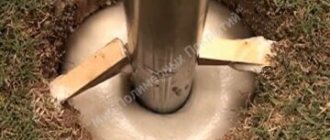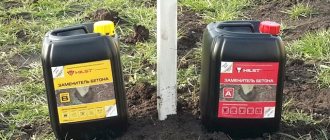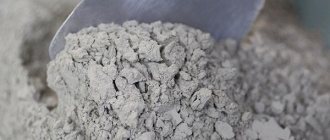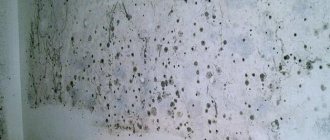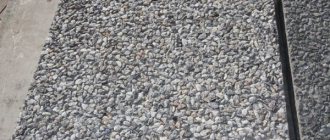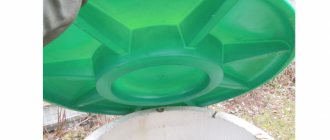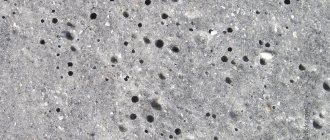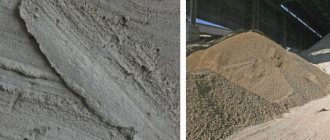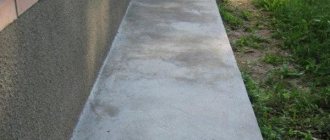Hilst two-component concrete substitute is used for the installation of small structures. It can be used by non-professional builders, does not require long-term shrinkage, hardens much faster than concrete, and does not leave behind dust and dirt. Provides strength and stability of structures, protects metal and wood from destruction, replacing a mixture of cement and sand requires less energy consumption during installation.
Composition and characteristics: what's special?
The concrete substitute “Hilst” consists of 2 jars with different liquid reagents. Thanks to their mixing, a reaction occurs and a substance appears that can replace the characteristics of a durable concrete mixture. When mixed, the mass becomes several times larger, foams and tightly fits the surfaces that need to be concreted. The coating is so dense and reliable that it does not allow water to get between the mounting post and the replacement in the future, and this automatically protects it from destruction.
When mixing the components, 1 liter of concrete substitute increases in proportion to 14 liters, which is equivalent to 40 kg of cement-sand mixture.
The solution poured into the hole begins to set within 5 minutes.
The volume of canisters in which the mixture is sold is 1.5 and 10 liters, depending on the volume of installation work. Mix Hilst for 15-30 seconds. The reaction occurs within 45 seconds. after the solution enters the pit. The duration of action during which the reaction occurs is 3-5 minutes. The concrete mix substitute gains strength within a maximum of 3 hours after use. In comparison, to use a support delivered using conventional concrete, you must wait up to 28 days, depending on weather conditions and the complexity of the structures.
What is good about the Hilst system?
We must immediately make a reservation that the Hilst system, due to its limited scope of application, cannot be called a 100% substitute for concrete. It is advisable to use the Hilst concrete substitute for fixing supports in special conditions:
- The need to work in conditions of low temperatures and permafrost;
- The need for the fastest possible construction of the structure;
- Increased requirements for the strength and quality of support installation.
In this regard, it is worth mentioning the main advantages of the Hilst system:
- Supplied in convenient plastic packaging with a capacity of 1, 10 and 40 liters of the main substance;
- Very fast polymerization within 5 minutes;
- One hundred percent filling of the hole for the support with simultaneous penetration into the surrounding soil - reliable fixation;
- The diameter of the hole in the floor support of the fixed Hilst system is two times smaller than for fixation with concrete mortar;
- Zero hygroscopicity and chemical activity - a guarantee of maximum durability of steel supports;
- Ability to work at very low (down to minus 25 degrees Celsius) temperatures, all other conditions being equal;
- "Cleanliness of work." When using Hilst, there is no waste in the form of unused sand, crushed stone and concrete.
Advantages
The concrete substitute "Hilst" has a number of advantages over the usual mixture. It is economically used, does not require professional skills, does not take up much space during transportation, and does not stain hands and clothes. In addition, in terms of quality, the concrete mix substitute has the following advantages:
In every sense, this material is much more convenient to use where conventional concrete is used.
- reliability of fixation;
- ease of installation;
- speed of installation;
- excellent adhesion to metal, wood, plastic, fiberglass;
- dielectric properties;
- frost resistance;
- safety for the environment and human health.
Product release form
At this point in time, the Hilst system manufacturer offers the following product packaging for sale:
- Hilst Standard. The volume of components is 1 liter, which replaces 40 kg of concrete mixture. The finished material is enough to fill 2 holes for supports. Cost from 750 rubles per unit;
- Hilst P Component volume – 10 liters. The specified quantity is enough to fill 20 holes. Cost from 6.5 thousand rubles per unit;
- Hilst Expert. The volume of components is 40 liters, which is enough to fill 70 holes. Cost from 24 thousand rubles.
Along with a large number of advantages, the Hilst system has a rather significant drawback - the high cost relative to the components of the concrete solution (cement, sand, crushed stone and water). Therefore, giving preference to the “convenience and speed” of installation using the Hilst concrete substitute, you need to be prepared for a significant increase in the cost of installation work.
Assortment of two-component products
Hilst is “divided” into several subtypes, depending on what it is used for installation:
- "Standard". Suitable for the construction of fences, barriers, canopies and parking bollards.
- "Professional". Used when installing fences more than 15 meters long, but no more than 2.5 m high.
- "Expert". Mixture for installation of power transmission poles, lamp posts, antennas.
It is much more economical to install a large number of supports with this solution.
The two-component composition is used in private construction, as well as by companies engaged in the construction of large objects. Everything depends on the type of mixture. If a large amount of support construction is required, it is advisable to use Hilst, since as a result it is cheaper and faster than using real concrete.
Composite compositions - concrete substitutes
"FAST 2k" (Canada)
"FAST 2k" is a composite building material produced by Canadian. Its specific purpose is the quick and high-quality installation of support posts for fences, as well as other vertical columnar structures.
Prices for concrete substitute
concrete substitute
"FAST2k" goes on sale in 1.1 kg bags, which will more than replace two bags of regular cement
In addition, the material can be used for arranging columnar foundations of light buildings, such as gazebos, verandas, terraces, and agricultural buildings.
Concrete substitute "FAST 2k" is a two-component polyurethane hydrophobic mixture. Its components react with each other when mixed. The material is an excellent alternative to cement-sand mortar, but, unlike it, the initial hardening time of “FAST 2k” occurs within just five minutes.
Process of mixing and using concrete substitute "FAST 2k"
One packet of substitute weighing 1.1 kg will replace the volume of 50 kg of concrete solution. In addition, making a concrete substitute will not take much time.
- “FAST 2k” packaging consists of a bag hermetically separated by a special strip. In different sections of such packaging there are two components that for the time being are not in contact with each other.
- Each package comes with protective gloves, in which it is recommended to carry out work.
- Before use, the dividing bar is removed from the bag, and the liquids inside the package are mixed for 30 seconds. To do this, you need to turn the package over several times.
- After mixing the contents, a corner is cut off from the package, and the mass is poured into the hole into which the pole is installed, leveled and temporarily fixed in the desired position.
- The poured mixture begins to actively expand, filling all possible empty space.
- Within five minutes, the mass hardens by 50%, after 15-20 minutes it becomes hard, and after two hours it gains, if we speak in terms common among concrete workers, “brand strength,” that is, it reaches full “ripening.”
- When the strength reaches its maximum, you can safely proceed to installing fencing elements on poles, hanging gates, installing piping on a columnar foundation, etc.
This concrete substitute is sold in two different packages:
- A large bag weighing 1.1 kg - as a result of preparing the mixture, 20 liters of hardened composite are obtained from this volume.
- Small packaging with a total volume of only 0.5 liters - it produces 9 liters of material.
The advantages of “FAST 2k”, when compared with conventional concrete mortar, are the following:
— Workers are given the opportunity to produce the required amount of material without special equipment (concrete mixers), without transporting numerous bags of sand, crushed stone and cement.
“The production of a concrete substitute does not require water, which means that work can be carried out on the site even before the installation of utilities. And do not carry a supply of technical water with you.
— I’m attracted by the thoughtfulness of the compact and convenient packaging, which allows mixing components without pouring the two components into separate containers.
— Unlike conventional concrete, “FAST 2k” can be used at temperatures down to -25 degrees. To do this, however, before starting work, the packaging with the composition should be kept in a warm room with a temperature of at least + 22÷24 degrees for two to three hours.
All the necessary material to strengthen a whole row of pillars can fit in one or two boxes
— When using a concrete substitute, you will not have to dig a large-diameter pit under the pillars.
Thus, one package of 1.1 liters will be enough to strengthen one post with a diameter of 100 mm (section 100×100 mm) in a well-equipped pit with a diameter of 200 mm and a depth of 900 mm, or two adjacent posts with a diameter of 100×100 mm in a hole 150×900 mm.
— Unlike concrete mortar, for which it is necessary to determine the proportions of the components, in the FAST 2k package the components are precisely dosed by the manufacturer.
— When working with a concrete substitute, there will be no dirt around the object being strengthened.
— Installation of fence posts or gazebos can be easily done in one day. Moreover, this is the period of complete readiness, which makes it possible to proceed to any subsequent operations.
— To store compact packages, you will not need a dry warehouse, which is required for cement.
— The composition is used without waste, since there are no losses due to accidentally torn bags of cement, as well as hardened residues in the container for mixing the solution.
— Everyone notes the excellent adhesion of the foam to any base and material of the pillars and walls of the pit.
This illustration shows how dense foam fills all the voids and bypasses all the protrusions present on the walls of the pit.
— The expanding composition evenly fills the entire space. No air voids are created inside the mass. And this without tamping or vibration!
— An important advantage is the hydrophobicity of the material. It does not allow moisture to pass through, thereby protecting the part of the pillar located below the soil surface from rotting. Therefore, the racks do not have to be treated with a moisture-resistant compound, which must be done when using concrete.
Prices for concrete substitute FAST2k
concrete substitute FAST2k
Material protruding above the soil surface can be cut off quite easily with a sharp knife until it reaches full strength.
— The composition can be added during operation, and if excess occurs, that is, if the expanded composite rises above the ground level, it can be easily removed by cutting.
It is estimated that the use of a concrete substitute saves installation time by 70%, reduces labor costs for transportation by 85% and for digging pits by 40%. And for the production of the composition 100%!
Agree, this is very cool!
Domestic materials - concrete substitutes
Similar composite materials produced by Russian companies have very similar characteristics, release form, and application technology. Therefore, they can be considered in one section.
Unlike the Canadian concrete substitute, Russian two-component compositions go on sale in two bottles or canisters, depending on the required volume of material. Mixing the two components is done using a mixer in a separate container or simply by hand shaking after pouring into one container.
Mixing two components of concrete substitute in a special measuring vessel.
Russian companies produce such composite compounds as “HILST”, “GPN-100” and “Betonit”. Before moving on to the general characteristics of these materials, a few words need to be said about each of them.
- “HILST”, like all its other analogues, appeared on the market quite recently, but has already gained popularity and numerous positive reviews from consumers. The composition is used to strengthen vertical supports in the ground, as well as for horizontal foundations for not too heavy buildings or when laying pipelines.
Buyers are offered three “HILST” options. They are identical in composition - the only difference is in the packaging and, accordingly, the scale of the planned work.
— “HILST Standard” is an ideal solution for installing poles. The set includes two bottles of 500 ml of each component. The volume of one of the containers is made larger - in this bottle, as a rule, it is done by mixing the ingredients (the same approach, by the way, is used by other manufacturers - one of the bottles is always larger in size so that a second component can be added to it).
Mixing two components of concrete substitute in a special measuring vessel.
— “HILST Professional” is a set of two canisters of five liters of each component. Mixing is done in a separate container. It is assumed that several teams will work simultaneously, for example, when installing a long fence or a pile field.
The same components are used - the only difference is in volume. On the left are two cans of the HILST Professional set, on the right are two buckets of HILST Expert.
— “HILST Expert” — a kit for solving complex problems, for example, installing power poles or other heavily loaded supports, strengthening foundations, etc. It consists of two capacious hermetically sealed buckets of 20 liters of each component.
Video: An example of installing a pole using a concrete substitute - the “HILST Standart” kit
- “GPN-100” and “Betonit-1” have the same characteristics and differ only in their name, as they are manufactured by different manufacturers. Both materials are used to strengthen vertical support structures.
Two more options for the Russian concrete substitute: Betonit-1 and GPN-100.
Two bottles contain the components from which the working composition is made. Their total volume is 1 liter. As mentioned above, the characteristics of domestic products are almost identical, but differ slightly from the Canadian material. However, the compositions all work on the same principle.
Pouring a pillar with a concrete substitute
So, from the characteristics of Russian compositions we can highlight:
- The production of a concrete substitute does not require the presence of water.
- When hardened, the material acquires high strength, which allows the supports to be securely fixed in a vertical position.
- After pouring the prepared mixture into the pit, tamping is not required, since no air bubbles form inside the mixture.
- Low composition consumption. Due to the increase in volume, the mass fills all the depressions formed inside the pit during its arrangement. One liter of a two-component polymer mixture is approximately equal in volume to 40 kg of concrete solution.
- Rapid hardening of the mass mixed and poured into the pit: the initial setting period is three minutes, and after three hours the material gains 100% strength. Here it is necessary to take into account that ordinary concrete gains strength only after 28-30 days.
- To use a concrete substitute, no formwork is required.
- It is quite possible to mix and pour any of the above-mentioned materials yourself, even if you have no construction experience.
- The hydrophobicity of the composition is an important factor for protecting installed supports from moisture, since it is the culprit that causes damage to both metal and wooden poles. Its dielectric qualities are also important - this is also a plus for safety from corrosion.
- High level of adhesion. The resulting foam adheres well not only to wood and metal, but also to the soil of the pit.
- The concrete substitute is an environmentally friendly product.
- When choosing a concrete substitute to strengthen pillars or the base of foundations, work can be carried out at temperatures down to minus 25 degrees.
The mixed mixture may have a light or dark color.
When using one of the domestic compositions, the following points should be taken into account:
- In order for the product to have all the qualities mentioned above after manufacturing, it is recommended to mix the two components at a temperature of + 15 ÷ 28 degrees.
- If the ambient temperature exceeds 20 degrees, the rate of reaction between the two components will increase, and if it is negative, it will slow down.
- If the mixing of two components will be carried out at an air temperature of 20 degrees or more, and it is planned to be done manually, then this process should be carried out for at least 20-30 seconds.
Prices for concrete substitute "Betonit-1"
concrete substitute Betonit-1
It would probably be interesting to see whether there is a significant difference in the physical, technical and operational characteristics of different compositions of this operating principle. You can use the following table, which summarizes the main indicators.
Application
To install a support in the ground, you need to dig a hole slightly larger than the diameter of the pole. A pillar is placed in it and filled with the Hilst solution mixed using a mixer. For proper installation, you need to hold the support in the correct position for 5 minutes. After 60 minutes, the pole is considered securely fixed so that the necessary accessories can be attached to it. When the solution gets into the well, the reaction between the components in the composition begins to occur more violently - the mass hisses and increases in size. This should not be feared, since such “behavior” of a concrete substitute is considered the norm.
When the material begins to “work”, this is noticeable by its visual expansion in volume and hissing.
Assortment and price
HILST StandardConvenient for private, single use. For “concreting” up to 15 pillars Packaging: 1.5 l (1 l can with a component volume of 0.5 l and a 0.5 l can with a volume of 0.5 l), weight 1 kg For concreting up to 2 pillars Price 950 rub. | HILST ProfessionalFor large volumes and professional installation teams. For installation of supports from 15 pcs. Packaging: 10 l (2 canisters of 5 l), 10 kg. For concreting up to 20 pillars Price 7,500 rub. | HILST ExpertFor highly loaded supports (power line poles) Packaging: 40 l (2 buckets of 20 l), 40 kg For installation of power line poles Price 27,000 rub. |
